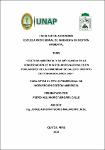Cultura ambiental y su implicancia en la conservación de sus recursos naturales en pobladores de la comunidad de Gallito. Distrito de Fernando Lores. 2021
Abstract
The study was called "Environmental culture and its implication in the conservation of its natural resources in residents of the Gallito community. District of Fernando Lores. 2021=. Having as objective "Determine what is the level of environmental culture and its implication in the conservation of its natural resources of the inhabitants of the Gallito study farmhouse. The non-experimental, quantitative research design was used. The research work is descriptive-transversal. A simple probabilistic sample was used, where 220 people who live in the study community were chosen. The results were developed through descriptive statistics, being: Applying the Rho Spearson test and relating it to the proposed hypothesis, this is rejected, since the inhabitants of Gallito have a low or deficient environmental culture. Regarding environmental attitudes, it is found that they are acceptable or good (29.1%) to very acceptable or excellent (70.9%) measured with the Liker scale. In environmental behavior there are values that go from good (80%) to excellent (16.4%). In environmental knowledge it can be seen that it is regular (79.5%) to good (20.5%). For the variable conservation of natural resources and knowledge of the ANP, in this population, results were obtained evaluated with a Liker scale, good (67.3%) and regular (32.7%). It is concluded by stating that, according to the perception of the inhabitants on environmental culture, they refer that it is part of their natural and cultural environment that they develop and their interrelation with it. El estudio se denominó <Cultura ambiental y su implicancia en la conservación de sus recursos naturales en pobladores de la comunidad de Gallito. Distrito de Fernando Lores. 2021=. Teniendo como objetivo <Determinar cu??l es nivel de cultura ambiental y su implicancia en la conservación de sus recursos naturales de los pobladores del caserío Gallito de estudio. Se utilizó el diseño de investigación no experimental, cuantitativa El trabajo de investigación es descriptivo-transversal. Se manejo una muestra probabilística simple, donde se escogió 220 personas que moran en la comunidad del estudio. Los resultados se desarrollaron a través de la estadística descriptiva, siendo: Aplicando la prueba de Rho Spearson y relacionándolo con la hipótesis planteada, esta se rechaza, puesto que los pobladores de Gallito poseen una cultura ambiental baja o deficiente. En cuanto a las actitudes ambientales se tiene que las mismas son aceptables o buenas (29.1%) a muy aceptables o excelentes (70.9%) medido con escala de Liker. En comportamiento ambiental se tiene valores que va de bueno (80%) a excelente (16.4%). En conocimientos ambientales se aprecia que es de regular (79.5%) a bueno (20.5%). Para la variable conservación de recursos naturales y conocimiento de las ANP, en esta población se obtuvieron resultados evaluados con escala Liker, bueno (67.3%) y regular (32.7%). Se concluye manifestando, que de acuerdo a la percepción de los pobladores sobre cultura ambiental, referien que se enmarca a su entorno natural y cultual que se desarrollan y su interrelación con el mismo.
Collections
- Tesis [501]


